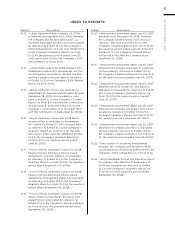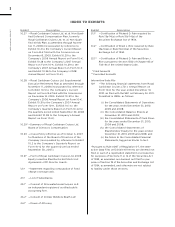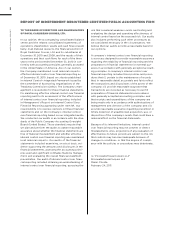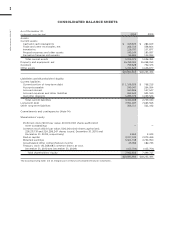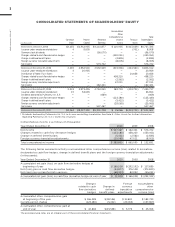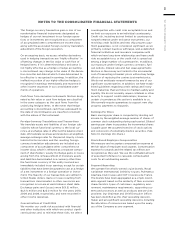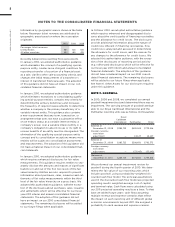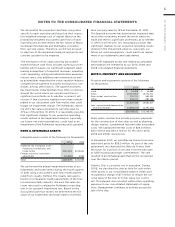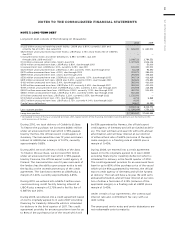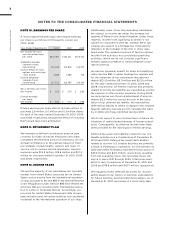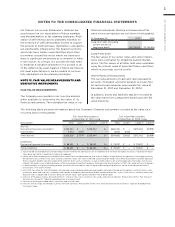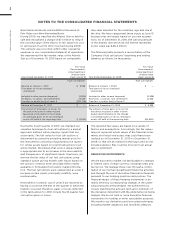Royal Caribbean Cruise Lines 2010 Annual Report Download - page 71
Download and view the complete annual report
Please find page 71 of the 2010 Royal Caribbean Cruise Lines annual report below. You can navigate through the pages in the report by either clicking on the pages listed below, or by using the keyword search tool below to find specific information within the annual report.
2010 ANNUAL REPORT 68
NOTES TO THE CONSOLIDATED FINANCIAL STATEMENTS
activities associated with those drydocking costs can-
not be performed while the vessel is in service and, as
such, are done during a drydock as a planned major
maintenance activity. The significant deferred dry-
dock costs consist of hauling and wharfage services
provided by the drydock facility, hull inspection and
related activities (e.g. scraping, pressure cleaning,
bottom painting), maintenance to steering propulsion,
stabilizers, thruster equipment and ballast tanks, port
services such as tugs, pilotage and line handling, and
freight associated with these items. We perform a
detailed analysis of the various activities performed
for each drydock and only defer those costs that are
directly related to planned major maintenance activi-
ties necessary to maintain Class. The costs deferred
are not otherwise routinely periodically performed to
maintain a vessel’s designed and intended operating
capability. Repairs and maintenance activities are
charged to expense as incurred.
Goodwill
Goodwill represents the excess of cost over the fair
value of net tangible and identifiable intangible assets
acquired. We review goodwill for impairment at the
reporting unit level annually or, when events or cir-
cumstances dictate, more frequently. The impairment
review for goodwill consists of a two- step process of
first determining the fair value of the reporting unit
and comparing it to the carrying value of the net assets
allocated to the reporting unit. If the fair value of the
reporting unit exceeds the carrying value, no further
analysis or write-down of goodwill is required. If the
fair value of the reporting unit is less than the carrying
value of the net assets, the implied fair value of the
reporting unit is allocated to all the underlying assets
and liabilities, including both recognized and unrec-
ognized tangible and intangible assets, based on their
fair value. If necessary, goodwill is then written down
to its implied fair value.
Intangible Assets
In connection with our acquisitions, we have acquired
certain intangible assets of which value has been
assigned to them based on our estimates. Intangible
assets that are deemed to have an indefinite life are
not amortized, but are subject to an annual impair-
ment test, or when events or circumstances dictate,
more frequently. The indefinite-life intangible asset
impairment test consists of a comparison of the fair
value of the indefinite-life intangible asset with its
carrying amount. If the carrying amount exceeds its
fair value, an impairment loss is recognized in an
amount equal to that excess. If the fair value exceeds
its carrying amount, the indefinite-life intangible asset
is not considered impaired.
Other intangible assets assigned finite useful lives are
amortized on a straight-line basis over their estimated
useful lives.
Contingencies—Litigation
On an ongoing basis, we assess the potential liabilities
related to any lawsuits or claims brought against us.
While it is typically very difficult to determine the tim-
ing and ultimate outcome of such actions, we use our
best judgment to determine if it is probable that we
will incur an expense related to the settlement or final
adjudication of such matters and whether a reason-
able estimation of such probable loss, if any, can be
made. In assessing probable losses, we take into
consideration estimates of the amount of insurance
recoveries, if any. We accrue a liability when we believe
a loss is probable and the amount of loss can be rea-
sonably estimated. Due to the inherent uncertainties
related to the eventual outcome of litigation and
potential insurance recoveries, it is possible that cer-
tain matters may be resolved for amounts materially
different from any provisions or disclosures that we
have previously made.
Advertising Costs
Advertising costs are expensed as incurred except
those costs which result in tangible assets, such as
brochures, which are treated as prepaid expenses
and charged to expense as consumed. Advertising
costs consist of media advertising as well as brochure,
production and direct mail costs. Media advertising
was $166.0 million, $152.2 million and $152.5 million,
and brochure, production and direct mail costs were
$104.1 million, $92.0 million and $100.0 million for the
years 2010, 2009 and 2008, respectively.
Derivative Instruments
We enter into various forward, swap and option con-
tracts to manage our interest rate exposure and to
limit our exposure to fluctuations in foreign currency
exchange rates and fuel prices. These instruments
are recorded on the balance sheet at their fair value
and the majority are designated as hedges. Our deriv-
ative instruments are not held for trading or specula-
tive purposes.
At inception of the hedge relationship, a derivative
instrument that hedges the exposure to changes in
the fair value of a recognized asset or liability, or a
firm commitment is designated as a fair value hedge.
A derivative instrument that hedges a forecasted
transaction or the variability of cash flows related to
a recognized asset or liability is designated as a cash
flow hedge.
Changes in the fair value of derivatives that are desig-
nated as fair value hedges are offset against changes
in the fair value of the underlying hedged assets,
liabilities or firm commitments. Gains and losses on
derivatives that are designated as cash flow hedges
are recorded as a component of accumulated other
comprehensive income (loss) until the underlying
hedged transactions are recognized in earnings.



